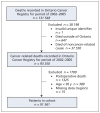Why do patients with cancer visit the emergency department near the end of life?
- PMID: 20231340
- PMCID: PMC2845683
- DOI: 10.1503/cmaj.091187
Why do patients with cancer visit the emergency department near the end of life?
Abstract
Background: For patients dying of cancer, a visit to the emergency department can be disruptive, distressing and exhausting. Such visits made near the end of life are considered an indicator of poor-quality cancer care. We describe the most common reasons for visits made to the emergency department during the final six months of life and the final two weeks of life by patients dying of cancer.
Methods: We performed a descriptive, retrospective cohort study using linked administrative sources of health care data.
Results: Between 2002 and 2005 in Ontario, 91,561 patients died of cancer. Of these, 76,759 patients made 194,017 visits to the emergency department during the final six months of life. Further, 31,076 patients made 36,600 visits to the emergency department during the final two weeks of life. In both periods, the most common reasons were abdominal pain, lung cancer, dyspnea, pneumonia, malaise and fatigue, and pleural effusion.
Interpretation: Many visits made to the emergency department by patients with cancer near the end of life may be avoidable. An understanding of the reasons for such visits could be useful in the development of dedicated interventions for preventing or avoiding their occurrence.
Figures
References
-
- Rowe B, Bond K, Ospina M, et al. Frequency, determinants, and impact of over-crowding in emergency departments in Canada: a national survey of emergency department directors. Ottawa (ON): Canadian Agency for Drugs and Technologies in Health; 2006. [(accessed 2010 Jan. 4)]. Available: www.cadth.ca/media/pdf/320c_Overcrowding_tr_e_no-appendices.pdf.
-
- Barbera L, Paszat L, Chartier C. Indicators of poor quality care in end of life cancer care in Ontario. J Palliat Care. 2006;22:12–7. - PubMed
-
- Earle CC, Park ER, Lai B, et al. Identifying potential indicators of the quality of end-of-life cancer care from administrative data. J Clin Oncol. 2003;21:1133–8. - PubMed
-
- Cancer System Quality Index. Toronto (ON): Cancer Care Ontario; 2009. [(accessed 2010 Jan. 4)]. Available: http://csqi.cancercare.on.ca.
Publication types
MeSH terms
LinkOut - more resources
Full Text Sources

